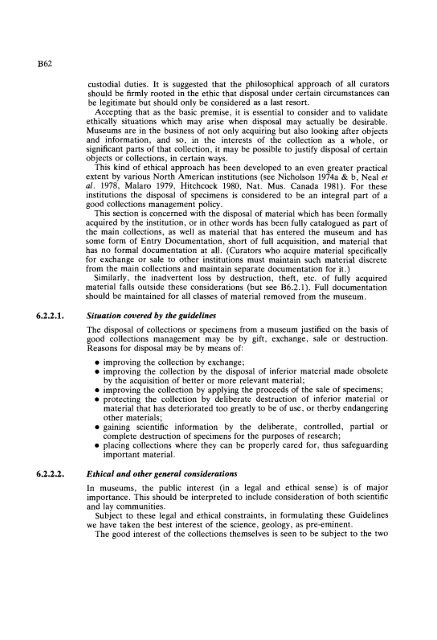GUIDELINES FOR THE CURATION OF GEOLOGICAL MATERIALS
GUIDELINES FOR THE CURATION OF GEOLOGICAL MATERIALS
GUIDELINES FOR THE CURATION OF GEOLOGICAL MATERIALS
You also want an ePaper? Increase the reach of your titles
YUMPU automatically turns print PDFs into web optimized ePapers that Google loves.
custodial duties. It is suggested that the philosophical approach of all curators<br />
should be firmly rooted in the ethic that disposal under certain circumstances can<br />
be legitimate but should only be considered as a last resort.<br />
Accepting that as the basic premise, it is essential to consider and to validate<br />
ethically situations which may arise when disposal may actually be desirable.<br />
Museums are in the business of not only acquiring but also looking after objects<br />
and information, and so, in the interests of the collection as a whole, or<br />
significant parts of that collection, it may be possible to justify disposal of certain<br />
objects or collections, in certain ways.<br />
This kind of ethical approach has been developed to an even greater practical<br />
extent by various North American institutions (see Nicholson 1974a & b, Neal et<br />
al. 1978, Malaro 1979, Hitchcock 1980, Nat. Mus. Canada 1981). For these<br />
institutions the disposal of specimens is considered to be an integral part of a<br />
good collections management policy.<br />
This section is concerned with the disposal of material which has been formally<br />
acquired by the institution, or in other words has been fully catalogued as part of<br />
the main collections, as well as material that has entered the museum and has<br />
some form of Entry Documentation, short of full acquisition, and material that<br />
has no formal documentation at all. (Curators who acquire material specifically<br />
for exchange or sale to other institutions must maintain such material discrete<br />
from the main collections and maintain separate documentation for it.)<br />
Similarly, the inadvertent loss by destruction, theft, etc. of fully acquired<br />
material falls outside these considerations (but see B6.2.1). Full documentation<br />
should be maintained for all classes of material removed from the museum.<br />
6.2.2.1. Situation covered by the guidelines<br />
The disposal of collections or specimens from a museum justified on the basis of<br />
good collections management may be by gift, exchange, sale or destruction.<br />
Reasons for disposal may be by means of:<br />
improving the collection by exchange;<br />
improving the collection by the disposal of inferior material made obsolete<br />
by the acquisition of better or more relevant material;<br />
improving the collection by applying the proceeds of the sale of specimens;<br />
protecting the collection by deliberate destruction of inferior material or<br />
material that has deteriorated too greatly to be of use, or therby endangering<br />
other materials;<br />
gaining scientific information by the deliberate, controlled, partial or<br />
complete destruction of specimens for the purposes of research;<br />
placing collections where they can be properly cared for, thus safeguarding<br />
important material.<br />
6.2.2.2. Ethical and other general considerations<br />
In museums, the public interest (in a legal and ethical sense) is of major<br />
importance. This should be interpreted to include consideration of both scientific<br />
and lay communities.<br />
Subject to these legal and ethical constraints, in formulating these Guidelines<br />
we have taken the best interest of the science, geology, as pre-eminent.<br />
The good interest of the collections themselves is seen to be subject to the two

















